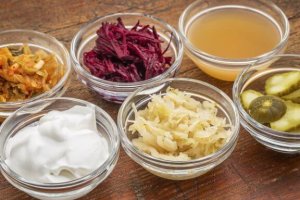What Is Food Fermentation and How Does It Benefit Your Health?

Food fermentation is nothing new; we’ve been consuming this type of food for thousands of years. Basic, traditional products such as bread, cheese or alcohol are still made using this process.
Nowadays, this technique is more popular than ever, and these foods are available in almost any supermarket. This is because fermented foods have a lot of beneficial properties for your body.
If you want to know more about this natural process, keep reading! We’ll explain in detail what it consists of and the different ways in which it benefits your health.
What does food fermentation consist of?
Food fermentation is a natural process in which food properties change due to the presence of certain bacteria. The fermentation doesn’t happen in every product, because the bacteria need a specific environment to develop and modify the product.
For this to happen, the food must contain sugar. This is the only way bacteria can change the properties of food.
The fermentation process can be natural or artificial. Natural fermentation happens when the bacteria are naturally present in the food. On the other hand, in the artificial fermentation process, bacteria are added to the foods that don’t contain them naturally.
Health benefits
As we’ve said before, this type of food is great for your health. In the next points, we’ll explain some of the qualities that stand out the most. You’ll be surprised to know how much a simple food can impact your health so positively.
It makes digestion easier
If you usually suffer from heavy digestion, experts recommend adding a fermented product to your daily diet. As a consequence of the action of micro-organisms, nutrients become simple molecules. That’s why your digestion becomes easier, and you can avoid that annoying feeling of a heavy belly; this is something we have all experienced on occasion.

It eliminates toxins and waste
Fermented food has a strong detoxifying action that can eliminate the toxins accumulated in your body. This is a natural way to clean your body and feel better. Besides, this property makes weight loss easier and stimulates the organs that perform this function, such as your kidneys, liver or bowel.
Food fermentation makes absorption of nutrients easier
As we’ve said before, micro-organisms ensure that nutrients become simple molecules. Since they’re simpler, your body can digest them better, so you benefit completely from the nutrients in food.
Improves your gut flora
Millions of micro-organisms that live in your intestine compose your microbiota. These bacteria are fundamental for the absorption of nutrients, the prevention or germs and the strengthening of your immune system.
Sometimes, they become damaged as a consequence of stress, diseases or a bad diet. So a great way of keeping them healthy is by consuming fermented foods to prevent this bacteria from becoming damaged and causing health problems.
Fermented foods
After hearing about all of the properties of fermented foods, you’re probably thinking about including them in your diet. There’s a lot of food with fermentation processes behind them. Besides, you can eat them in different ways, so it’s almost impossible to become bored with them.
- Sauerkraut: a classic food in Germany, consisting of fermented cabbage. People usually eat it as a side dish with meat or salads. This food is also a source of vitamins C and K.

- Kefir: a similar product to regular yogurt. It contains probiotics that also impact your body in a very positive way.

- Kombucha: this fermented drink is almost unheard of, but it deserves to be mentioned because of the huge number of properties it contains. It’s tea with a sour taste, originating from eastern countries.

- Miso: a basic fermented product from kitchens in countries such as China and Japan. It’s the result of fermenting soy along with other cereal; people usually add it to soups.

Food fermentation is something that has accompanied people’s nutrition through the centuries. Today we know about its benefits and have the possibility of using them in different ways. So, which one was your favorite?
Food fermentation is nothing new; we’ve been consuming this type of food for thousands of years. Basic, traditional products such as bread, cheese or alcohol are still made using this process.
Nowadays, this technique is more popular than ever, and these foods are available in almost any supermarket. This is because fermented foods have a lot of beneficial properties for your body.
If you want to know more about this natural process, keep reading! We’ll explain in detail what it consists of and the different ways in which it benefits your health.
What does food fermentation consist of?
Food fermentation is a natural process in which food properties change due to the presence of certain bacteria. The fermentation doesn’t happen in every product, because the bacteria need a specific environment to develop and modify the product.
For this to happen, the food must contain sugar. This is the only way bacteria can change the properties of food.
The fermentation process can be natural or artificial. Natural fermentation happens when the bacteria are naturally present in the food. On the other hand, in the artificial fermentation process, bacteria are added to the foods that don’t contain them naturally.
Health benefits
As we’ve said before, this type of food is great for your health. In the next points, we’ll explain some of the qualities that stand out the most. You’ll be surprised to know how much a simple food can impact your health so positively.
It makes digestion easier
If you usually suffer from heavy digestion, experts recommend adding a fermented product to your daily diet. As a consequence of the action of micro-organisms, nutrients become simple molecules. That’s why your digestion becomes easier, and you can avoid that annoying feeling of a heavy belly; this is something we have all experienced on occasion.

It eliminates toxins and waste
Fermented food has a strong detoxifying action that can eliminate the toxins accumulated in your body. This is a natural way to clean your body and feel better. Besides, this property makes weight loss easier and stimulates the organs that perform this function, such as your kidneys, liver or bowel.
Food fermentation makes absorption of nutrients easier
As we’ve said before, micro-organisms ensure that nutrients become simple molecules. Since they’re simpler, your body can digest them better, so you benefit completely from the nutrients in food.
Improves your gut flora
Millions of micro-organisms that live in your intestine compose your microbiota. These bacteria are fundamental for the absorption of nutrients, the prevention or germs and the strengthening of your immune system.
Sometimes, they become damaged as a consequence of stress, diseases or a bad diet. So a great way of keeping them healthy is by consuming fermented foods to prevent this bacteria from becoming damaged and causing health problems.
Fermented foods
After hearing about all of the properties of fermented foods, you’re probably thinking about including them in your diet. There’s a lot of food with fermentation processes behind them. Besides, you can eat them in different ways, so it’s almost impossible to become bored with them.
- Sauerkraut: a classic food in Germany, consisting of fermented cabbage. People usually eat it as a side dish with meat or salads. This food is also a source of vitamins C and K.

- Kefir: a similar product to regular yogurt. It contains probiotics that also impact your body in a very positive way.

- Kombucha: this fermented drink is almost unheard of, but it deserves to be mentioned because of the huge number of properties it contains. It’s tea with a sour taste, originating from eastern countries.

- Miso: a basic fermented product from kitchens in countries such as China and Japan. It’s the result of fermenting soy along with other cereal; people usually add it to soups.

Food fermentation is something that has accompanied people’s nutrition through the centuries. Today we know about its benefits and have the possibility of using them in different ways. So, which one was your favorite?
All cited sources were thoroughly reviewed by our team to ensure their quality, reliability, currency, and validity. The bibliography of this article was considered reliable and of academic or scientific accuracy.
- Recetas, M., Fermentados, A., & Sencillas, R. (2015). Fermentación: Cómo hacer chucrut. Eva Muerde La Manzana.
- Vega, E. (2012). Producción de Alimentos por Actividad Bacteriana – Fermentación. Universidad de Puerto Rico, 1, 12. https://doi.org/10.1108/17511340810893090
- Montano, A., De Castro, A., & Rejano, L. (1992). Transformaciones bioquímicas durante la fermentación de productos vegetales. Grasas y Aceites, 43(6), 352–360. https://doi.org/10.3989/gya.1992.v43.i6.1132
This text is provided for informational purposes only and does not replace consultation with a professional. If in doubt, consult your specialist.








